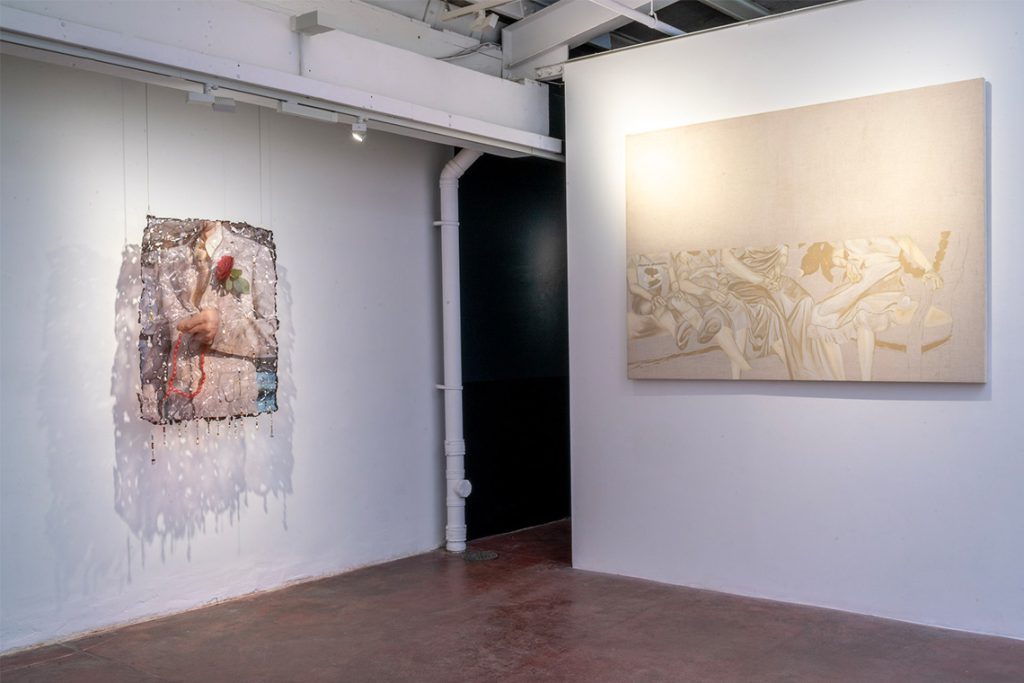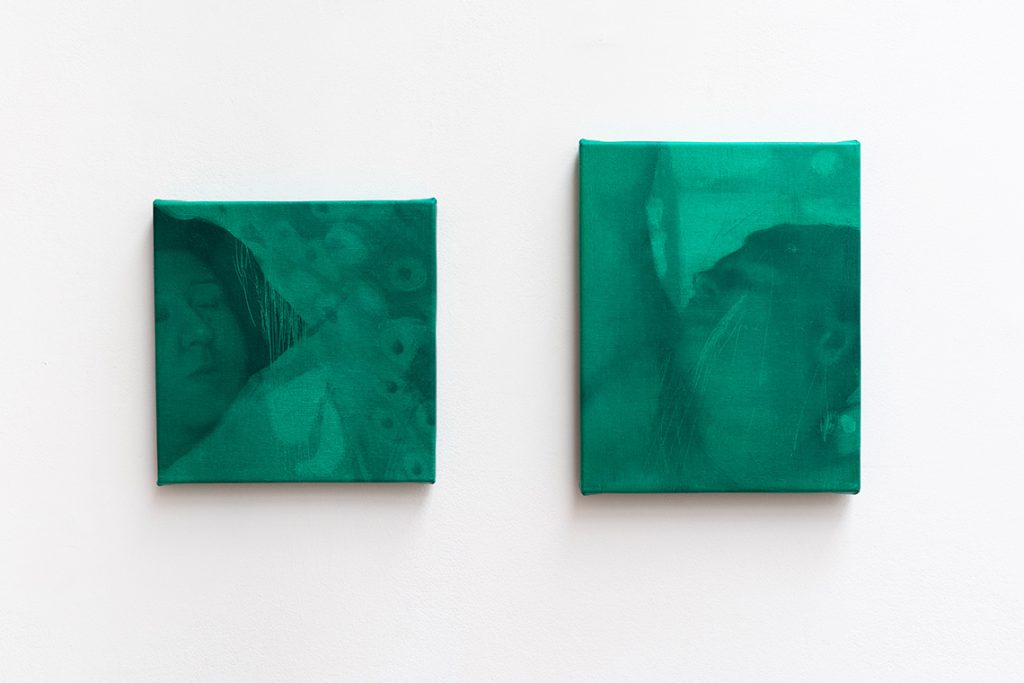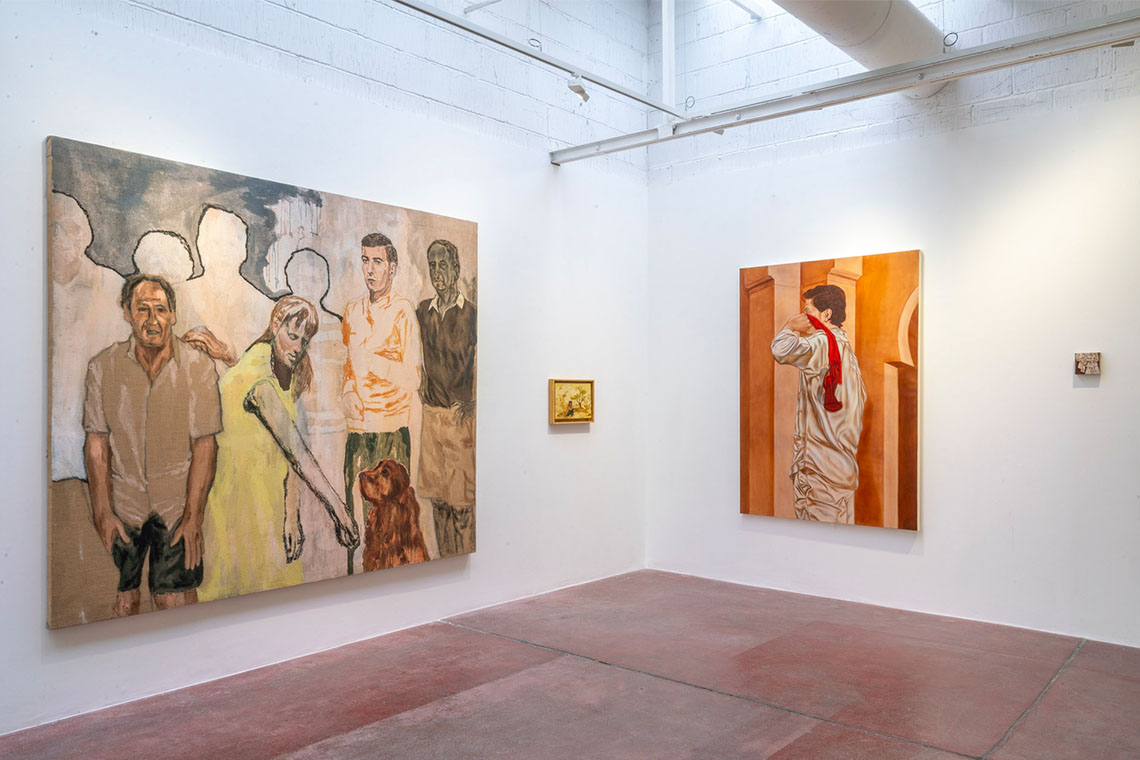Arab curatorial duo Hayaty Diaries opened their sixth showcase secondskin during London Frieze week.
The buzz for a young, new, seemingly subversive curatorial project begins in the glow of Instagram. Stories spray out posters for their latest showcase; comments from hip artists, curators and PR execs around me – including the aspiring and adjacent – ribbon out under the promo posts. The collective I have chosen to belong to digitally swarms protectively around the idea of this new venture, investing in, and thereby helping create, its press and success.
This is how I learned about Hayaty Diaries, made up of Christina Shoucair and Kinzy Diab, a Lebanese and Egyptian-Saudi curatorial pair in their twenties. In late 2023, they held their debut one-week exhibition Through Their Eyes: Perspectives Unveiled. The works were all by young female artists impressively spanning Bahrain, Egypt, Jordan, Lebanon, Morocco, Oman, Palestine, Saudi Arabia and the UAE.
Since then, Hayaty Diaries have held four more pop-up exhibitions in various London venues around the same conceit: bringing emerging female artists from across the Arab world together, putting their work in dialogue and increasing their visibility to collectors and wider audiences. Their sixth show, which launched during London’s busiest art week of the year during Frieze, is titled secondskin. “Skin is more than flesh”, its statement reads, but it is also about memory and the imagination, and their hold on everything that touches us, physically and metaphorically.

The show’s six artists – Amina Yahia, Fa Razavi, Tiyana Mitchell, Leily Moghtader Mojehi, Elias Loudiyi and Yasmina Hilal – are connected through works that purportedly “experience the body as a field of encounters”. This is soft impact framing – gentle and slightly tenous. I arrive at the show’s opening through a nondescript black gate into Greatorex in Whitechapel and the independent arts space is filled with pockets of young people. The exhibition poster is a delicate, hazy photograph of a human back, glazed with water droplets and minimalist typewritten font. It is curated tenderness.
Despite the gentility, I am surprised that there are mostly figurative paintings, some lusciously large scale. These appear to draw on the supple and fluid textures of not just skin but tactility itself. Tiyana Mitchell paints from her family’s photographic archives, making old images look molten. For me, they carry an unsettling lamination effect; this technique works best when at a bigger scale, as in Roll 21: London: 2025: 3 (2025), even though showcasing more technical prowess than an embodied feel of memory.
Yasmina Hilal’s photo-sculpture The Rose Endures (2025) stays with me longest – its way of creating both softness and its absence at once, through materiality. The work stages a photograph of a man in Hilal’s grandmother’s Tripoli neighbourhood, dressed in her brother’s old suit, smoking a cigarette in one hand with a masbaha (prayer beads) in the other. A rose sits in his lapel. The image is cropped and printed onto a sheet of acetate that is bleached and burned at the edges, making it appear like a sentimental vintage photograph and glossy, crumpled plastic at the same time – two temporalities and moods smashing together. Meanwhile, sparkling prayer beads hang off the print, like glassy raindrops. The work’s translucent, dripping reflection looks like crystal forming on the wall behind; it makes me think of what a precious memory would look like if it were made solid.
We see only the faces of two sleeping figures (apparently in the same bed, but divided in our gazes) in Iranian-born artist Fa Rizavi’s small and eerily beautiful Untitled (2025) paintings. These, too, are difficult to forget. One reminds me of the sneaky pictures you take of a loved one while splayed out in their sleep, so you can show them the next morning for a laugh. But Rizavi’s paintings are quiet and haunting, suffused in the artist’s signature emerald green, somehow with the soft grainy feel of CCTV footage. The peace of sleep, of deep rest, is tinged with a disturbance that makes me pause longer at the work.

I had been waiting to see new artwork by Egyptian painter Amina Yahia since I first saw an earlier painting of hers at Dubai’s Firetti Contemporary gallery in 2022. In the midst of gearing up for her first solo show in Kuwait, she has two large paintings in the Greatorex exhibition: Let me tell you how it all happened (2025) and Arayes (2022). The former is the showstopper in terms of colour and content, feeling like a subtle paean to migration and ecofeminism. I liked it primarily, however, for a visceral absence of male gaze, imposed or internalised, within its contemporary representation of the nude; at the same time, the texture of the figure’s skin looks smoothed and flattened compared to painted nudes of the past, like clay almost.
Finally, I wished dearly for the show to include labels for the works. Without scanning the QR code at the entrance, I inhaled all the art without knowing who each work was by. I then returned to scan it and trawled through the show again in dialogue with the details on my phone. In an exhibition about skin, touch and memory, I wanted to forget about the device in my hand and totally surrender to the painted folds of fabric and limbs around me on the walls.
secondskin seems softer in many ways relative to past Hayaty Diaries shows, but it carries out its conceit consistently, with increasing assuredness in its short-term popup format. The works here cohere well, most notably trying to highlight the possible top artists of tomorrow, today, while nurturing the growing representation of Arab female art in the UK and international art scene.
secondskin runs until 26 October



